Kanohi ki te kanohi
2 likes1,108 views
This document summarizes a hui (meeting) that was held to discuss issues affecting M®°ori students in the education sector. The hui brought together principals, teachers, families, and students to present the Ka Hikitia document and begin reflecting on how to improve measurable gains for M®°ori students. Participants discussed important issues in breakout groups and shared perspectives. Students also had a chance to voice what was important to them at their schools. The hui emphasized working together collectively and empowering voices to help raise achievement for M®°ori children through encouragement and celebration of successes.
1 of 11
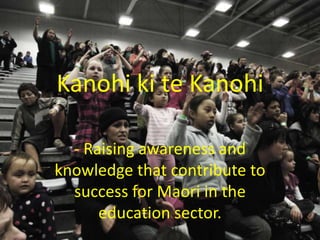










Recommended
UFA Transforming Learning



UFA Transforming LearningNational Association for Neighbourhood Management
?
∫›∫›fl£s used by Sarah Burgess, of the University of the First Age (UFA), at the 'Young people and Big Local' networking and learning event in Birmingham. The event took place on Saturday 5 July 2014.
UFA are a national education charity dedicated to raising the aspirations of children and young people aged 5 - 25. A lot of their activities are about helping young people become leaders, and they are especially interested in helping young people get others their age involved.Community Engagement 



Community Engagement Daniel M Groenewald
?
A basic professional learning template for discussing the importance of connection between home and school in Aboriginal communities Team A Week 8 perceptions



Team A Week 8 perceptionsjbinnert
?
The document discusses perceptions needed for an organized school, family, and community partnership program. It identifies key perceptions for principals, teachers, parents, and community members. The principal must see their role as one of accountability and serve students and the partnership. Teachers and parents must work closely together as the student support system and be collaborative. Community members must see themselves as benefactors of the local school and value intellectual pursuit and students as future community members.The motivating school



The motivating schoolireneroy2000
?
The document discusses schools as organizations, describing their common purpose of educating students and passing on societal values, as well as their typical hierarchical structures with defined roles and lines of authority. It also examines factors that influence organizational culture and the challenges of implementing change in schools, noting teachers are well-positioned as agents of change but often lack decision-making power and administrative support. Issues facing South African schools are then discussed, such as inadequate infrastructure and the crisis in the Eastern Cape education system.Consider The Evidence Tpu Ti Cs



Consider The Evidence Tpu Ti Csheather bell
?
This document discusses using data and evidence to make decisions to improve teaching and learning in Teen Parent Units. It considers what data is collected, why, and how it is used. Evidence-driven decision making requires analyzing data to understand patterns and insights that can inform changes to improve student achievement. The document outlines a cycle for evidence-based inquiry including speculating about issues, exploring the evidence, questioning, assembling data, analyzing, intervening, evaluating the impact of changes, and reflecting on lessons learned. Teachers are encouraged to use this process to set goals for improving their practice using an evidence-based approach.Aligning Professional Practice With Te Ara Whakamana: Mana Enhancement



Aligning Professional Practice With Te Ara Whakamana: Mana EnhancementTeAraWhakamana
?
Strategic leadership to embed Te Ara Whakamana requires us to recognise the links to documents that support the development of cultural competencies and inclusive educational practice in our schools. As we move forward, developing a framework for sustainable practice within the kaupapa of Te Ara Whakamana, along with solid inquiries to support ongoing teacher learning, by understanding the links to where Te Ara Whakamana situates itself alongside documents such as T®°taiako and Tapas®° or the Learning Support Action Plan, will support effective pedagogical practice and strategic planning.
As the SENCO and Learning Support Coordinator at Arahoe School, Pia Harr®¶ supports the implementation of Te Ara Whakamana ®C Mana Enhancement in this large urban school. Entering their fifth year of being a TAW school, the inquiries that have supported the thinking and actioning of TAW has culminated in wanting to develop a rubric to support a sustainable model for all.NLC Ramanui



NLC Ramanuiheather bell
?
Ramanui School is committed to providing an education that empowers M®°ori students and strengthens their cultural identity. The school aims to develop curriculum that meets the needs of its diverse community and provides opportunities to learn te reo M®°ori and tikanga. It also focuses on building strong partnerships with parents and the local community to improve student outcomes.Nlc



Nlclizziemay
?
Ramanui School is committed to providing an education that empowers M®°ori students and strengthens their cultural identity. The school aims to develop curriculum that meets the needs of its diverse community and provides opportunities to learn te reo M®°ori and tikanga. It also focuses on building strong partnerships with parents and the local community to improve student outcomes.Napp inquiry presentation



Napp inquiry presentationnekeadams
?
The document discusses Team Whero's inquiry into providing opportunities for "student voice" at Whangarei Intermediate School. It explores why student voice is important for learning, evaluating teaching, school improvement, developing student leadership, and shaping school culture. It also describes methods used to lead change, such as surveying students and teachers. While opportunities for student voice have increased, student understanding of its purpose has not, and further work is needed to fully embed it in classroom practice and culture.Community Engagement L@S



Community Engagement L@SCheryl Doig
?
This presentation explores the ways in which community can be involved in schools, using five levels of engagement to develop rich, ongoing partnerships in learning.Napp presentation rachel olson 1a



Napp presentation rachel olson 1aRachelOlson123
?
Rachel Olson outlines her experience and beliefs about leadership. She believes the most effective way for a principal to affect change is by mentoring and coaching teachers to impact multiple classrooms. With experience as an associate principal, head of departments, and leading professional development, her skills include effective communication, collaboration, and creating a shared vision to inspire others. She aims to promote Maori learning and culture, build community partnerships, and create future-focused schools emphasizing key competencies, modern learning environments, and real-life, skills-based education.Innovation for Impact on Education



Innovation for Impact on EducationNadine Metzger
?
Connecting Education and Communities is disruptive social innovation designed to break the cycle of disadvantage by strengthening the ownership of education within communities, and strengthening the connections between communities and education. This 10 year project is funded by the JR McKenzie Trust.Te Ao Takepu o te Whanau



Te Ao Takepu o te WhanauTeiva Akavi
?
This document outlines a program focused on adopting a Maori worldview and empowering whanau. The vision is to use Maori values, beliefs, and aspirations in education. The mission is to equip whanau with self-reflection skills using Maori knowledge to understand the visible and invisible universe. The program principles are based on Maori knowledge and aim to strengthen teaching and learning to raise the status of Maori people. It seeks to build tribal knowledge into programs and focus on unlocking whanau's diverse potential.Samir kumar sahoo and laxmi barik



Samir kumar sahoo and laxmi barikUniversity of Hyderabad, Telangana, India
?
This document discusses learning to live together, one of the four pillars of education according to the Delors report. It provides objectives and importance of learning to live together, the role of educators, and ways to promote it inside and outside of school. Some key points include strengthening ethical decision making and understanding of other cultures, promoting respect for diversity, and developing activities like role plays, group discussions, and community involvement to teach values of cooperation and living harmoniously.A Safe and Inspiring Space for Early Learning in Terrigal



A Safe and Inspiring Space for Early Learning in TerrigalJinky Skiddy
?
Child Care Terrigal is a premium early learning centre dedicated to providing exceptional care and education for children aged six weeks to five years. Located in the scenic coastal town of Terrigal, the centre offers a nurturing and stimulating environment where children can grow, explore, and thrive.
The programs are carefully designed to align with the Early Years Learning Framework (EYLF), focusing on holistic development across cognitive, social, emotional, and physical domains. Experienced educators create engaging, play-based activities tailored to each child°Øs unique needs and interests, fostering creativity, independence, and confidence.
The centre features state-of-the-art indoor learning spaces and vibrant outdoor play areas that inspire exploration and active play while maintaining safety and comfort. Families are welcomed as active partners in their child°Øs learning journey through open communication and involvement. Child Care Terrigal is dedicated to helping children build a strong foundation for a bright and successful future.
Link here: https://www.dinkydikids.com.au/terrigal-beach/Buckhorn Learning Community



Buckhorn Learning CommunityWendy Stephens
?
The document summarizes the Learning Community program at Buckhorn High School, which aims to help students with disabilities achieve their IEP goals. The Learning Community provides a structured environment with a focus on daily living, vocational, communication and social skills. It incorporates elements like Friendship Day, music class, peer mentoring and vocational activities to improve students' social skills and transition to independent living. The program emphasizes teamwork and collaboration between special education, regular education, administrators, parents and the community to create a positive learning environment.Participation policy nursery



Participation policy nurseryAP Pietri
?
This document outlines a nursery policy from Stronsay Junior High School aimed at developing children's participation. It defines participation as having influence over decisions and actions, not just taking part. Meaningful participation requires positive child-adult relationships and engaging children in dialogue. The benefits of involving children in decision making include fulfilling their rights, empowerment, improving services, developing citizenship and life skills. The policy aims to have children's views listened to and valued at the school and nursery by consulting them in age-appropriate ways on issues that affect them.Pyp mic presentation



Pyp mic presentationEnglish Montreal School Board
?
The document describes the Primary Years Programme at Michelangelo International Elementary School. It provides an overview of the school's mission, vision, and values which emphasize academic excellence, developing lifelong learners, and fostering international-mindedness. The school implements both the Quebec Educational Program and the International Baccalaureate Primary Years Programme (PYP), focusing on developing inquiry, communication, thinking, and social skills in students.Engaging Maori learners



Engaging Maori learnersKate Timms-Dean
?
Timms-Dean, K., & Rudd, J. (2011, October). Engaging Maori learners [PowerPoint slides]. Paper presentes at the National Tertiary Teaching & Learning Conference 2011, Nelson, New Zealand. Teaching as inquiry and Tataiako



Teaching as inquiry and Tataiakomshasanbegovic
?
This document discusses teaching strategies and cultural competencies used at South Otago High School. It outlines the Teaching as Inquiry model and the Effective Teaching Profile which includes elements like Manaakitanga, Mana motuhake, and Ako. Culturally responsive tools mentioned include building relationships through the He Kakano model, using feedback/feed-forward, and reciprocal teaching. The document emphasizes that developing teacher-student relationships is important for learning and discusses strategies like focusing on a group of students and their achievement through inquiry.Teacher & parents involvement



Teacher & parents involvementmuhammad shoaib
?
The document discusses the roles of teachers, parents, and technology in promoting students' learning. It states that teachers facilitate learning through classroom management and linking the school to the community. Parents are students' first teachers and their involvement in their child's education, like helping with homework and communicating with the school, contributes to academic success. The document also notes that technology supports different learning styles and allows students to learn through online resources.Teachers as counselors and visionaries -the need of the hour delivered at Te...



Teachers as counselors and visionaries -the need of the hour delivered at Te...Chandan Kumar
?
This document discusses the need for workshops and trainings to empower teachers and improve the education system. It addresses several challenges facing education today, including lack of resources, disparity in exposure levels between teachers and students, and the inability to keep up with changing times. The key messages are:
1) Regular workshops are needed to help teachers adapt to new technologies and trends, address generation gaps, and improve skills in areas like assessment and evaluation.
2) Both operational and transformational changes are required across areas like personnel management, infrastructure, curriculum, and teaching methods to enhance the learning experience.
3) Successful teachers employ a variety of skills and develop a personal teaching style that fits their personality and philosophy, while providingEngaging M®°ori learners



Engaging M®°ori learnersKate Timms-Dean
?
This is the presentation for a paper presented by Kate Timms-Dean and Jenny Rudd (Otago Polytechnic) at the National Tertiary Learning & Teaching Conference 2011, in Nelson, New Zealand.
The presentation provides a pedagogical framework for M®°ori learner engagement based on tikanga M®°ori (M®°ori custom) and models such as strengths and empowerment theories.PJI Newsletter, Volume 4, No 1



PJI Newsletter, Volume 4, No 1VCPJI
?
This newsletter highlights the Peace and Justice Initiative's Spring 2013 semester at Valencia College!Agency Project presentation.pptxsocialwr



Agency Project presentation.pptxsocialwrNicoleHolder4
?
Agency project on professional development in Social-Work.Matthew Spearing, Statement of Philosophy



Matthew Spearing, Statement of PhilosophyMatthew Spearing
?
Matthew Spearing believes that schools are primarily social institutions where education is a process of living, not just preparation for the future. He is drawn to supporting critical thinking skills, resilience, collaboration, and cultural competency through intentional programs. It is important to recognize both personal similarities and cultural differences when cultivating progress. He aims to mentor students so they can navigate challenges like racism, sexism, and technology through effective communication, resilience, and sensibility. Experiential education enhances understanding and test scores, so tangible learning experiences are important for academic programs.Building Partnership with the Community.ppt



Building Partnership with the Community.pptrhioamor001
?
The document discusses the importance of building partnerships between schools and their local communities. It provides objectives and activities for teachers to identify community resources and establish linkages. These include mapping community resources, norms, and practices that can help schools achieve goals. Quality education is a shared responsibility between schools and stakeholders like parents, organizations, and civic groups. The document offers tips for teachers to effectively coordinate with communities and enlist support through the PTA on issues like home visits, seminars, and two-way communication. [END SUMMARY]Evoking & Creating wisdom



Evoking & Creating wisdomCP Yen Foundation ≥Ø∞ÓŒƒΩê˘Ωï˛
?
This document discusses the art of facilitation and how it can be used to evoke and create wisdom within groups. It describes facilitation as drawing out a group's existing wisdom to solve problems or create solutions. The key skill of a facilitator is guiding reflective thinking by asking questions that move a group from recalling experiences to interpreting meaning and making decisions. When done respectfully, this process allows groups to integrate knowledge and come to a consensus beyond what any individual could achieve alone. Facilitation seeks to represent all stakeholders to consider every perspective in developing wise solutions.Sole charge teaching principal 2011 conference



Sole charge teaching principal 2011 conferenceheather bell
?
presentation given by Mary Mayes (principal at Tareha School) at the Sole Charge Principals' Conference in NZ, May 2011E Learning Hui Isteam Project V2



E Learning Hui Isteam Project V2heather bell
?
This presentation describes the research done by a group of school advisers who identified the key strategies for facilitating an online professional learning community.More Related Content
Similar to Kanohi ki te kanohi (20)
Napp inquiry presentation



Napp inquiry presentationnekeadams
?
The document discusses Team Whero's inquiry into providing opportunities for "student voice" at Whangarei Intermediate School. It explores why student voice is important for learning, evaluating teaching, school improvement, developing student leadership, and shaping school culture. It also describes methods used to lead change, such as surveying students and teachers. While opportunities for student voice have increased, student understanding of its purpose has not, and further work is needed to fully embed it in classroom practice and culture.Community Engagement L@S



Community Engagement L@SCheryl Doig
?
This presentation explores the ways in which community can be involved in schools, using five levels of engagement to develop rich, ongoing partnerships in learning.Napp presentation rachel olson 1a



Napp presentation rachel olson 1aRachelOlson123
?
Rachel Olson outlines her experience and beliefs about leadership. She believes the most effective way for a principal to affect change is by mentoring and coaching teachers to impact multiple classrooms. With experience as an associate principal, head of departments, and leading professional development, her skills include effective communication, collaboration, and creating a shared vision to inspire others. She aims to promote Maori learning and culture, build community partnerships, and create future-focused schools emphasizing key competencies, modern learning environments, and real-life, skills-based education.Innovation for Impact on Education



Innovation for Impact on EducationNadine Metzger
?
Connecting Education and Communities is disruptive social innovation designed to break the cycle of disadvantage by strengthening the ownership of education within communities, and strengthening the connections between communities and education. This 10 year project is funded by the JR McKenzie Trust.Te Ao Takepu o te Whanau



Te Ao Takepu o te WhanauTeiva Akavi
?
This document outlines a program focused on adopting a Maori worldview and empowering whanau. The vision is to use Maori values, beliefs, and aspirations in education. The mission is to equip whanau with self-reflection skills using Maori knowledge to understand the visible and invisible universe. The program principles are based on Maori knowledge and aim to strengthen teaching and learning to raise the status of Maori people. It seeks to build tribal knowledge into programs and focus on unlocking whanau's diverse potential.Samir kumar sahoo and laxmi barik



Samir kumar sahoo and laxmi barikUniversity of Hyderabad, Telangana, India
?
This document discusses learning to live together, one of the four pillars of education according to the Delors report. It provides objectives and importance of learning to live together, the role of educators, and ways to promote it inside and outside of school. Some key points include strengthening ethical decision making and understanding of other cultures, promoting respect for diversity, and developing activities like role plays, group discussions, and community involvement to teach values of cooperation and living harmoniously.A Safe and Inspiring Space for Early Learning in Terrigal



A Safe and Inspiring Space for Early Learning in TerrigalJinky Skiddy
?
Child Care Terrigal is a premium early learning centre dedicated to providing exceptional care and education for children aged six weeks to five years. Located in the scenic coastal town of Terrigal, the centre offers a nurturing and stimulating environment where children can grow, explore, and thrive.
The programs are carefully designed to align with the Early Years Learning Framework (EYLF), focusing on holistic development across cognitive, social, emotional, and physical domains. Experienced educators create engaging, play-based activities tailored to each child°Øs unique needs and interests, fostering creativity, independence, and confidence.
The centre features state-of-the-art indoor learning spaces and vibrant outdoor play areas that inspire exploration and active play while maintaining safety and comfort. Families are welcomed as active partners in their child°Øs learning journey through open communication and involvement. Child Care Terrigal is dedicated to helping children build a strong foundation for a bright and successful future.
Link here: https://www.dinkydikids.com.au/terrigal-beach/Buckhorn Learning Community



Buckhorn Learning CommunityWendy Stephens
?
The document summarizes the Learning Community program at Buckhorn High School, which aims to help students with disabilities achieve their IEP goals. The Learning Community provides a structured environment with a focus on daily living, vocational, communication and social skills. It incorporates elements like Friendship Day, music class, peer mentoring and vocational activities to improve students' social skills and transition to independent living. The program emphasizes teamwork and collaboration between special education, regular education, administrators, parents and the community to create a positive learning environment.Participation policy nursery



Participation policy nurseryAP Pietri
?
This document outlines a nursery policy from Stronsay Junior High School aimed at developing children's participation. It defines participation as having influence over decisions and actions, not just taking part. Meaningful participation requires positive child-adult relationships and engaging children in dialogue. The benefits of involving children in decision making include fulfilling their rights, empowerment, improving services, developing citizenship and life skills. The policy aims to have children's views listened to and valued at the school and nursery by consulting them in age-appropriate ways on issues that affect them.Pyp mic presentation



Pyp mic presentationEnglish Montreal School Board
?
The document describes the Primary Years Programme at Michelangelo International Elementary School. It provides an overview of the school's mission, vision, and values which emphasize academic excellence, developing lifelong learners, and fostering international-mindedness. The school implements both the Quebec Educational Program and the International Baccalaureate Primary Years Programme (PYP), focusing on developing inquiry, communication, thinking, and social skills in students.Engaging Maori learners



Engaging Maori learnersKate Timms-Dean
?
Timms-Dean, K., & Rudd, J. (2011, October). Engaging Maori learners [PowerPoint slides]. Paper presentes at the National Tertiary Teaching & Learning Conference 2011, Nelson, New Zealand. Teaching as inquiry and Tataiako



Teaching as inquiry and Tataiakomshasanbegovic
?
This document discusses teaching strategies and cultural competencies used at South Otago High School. It outlines the Teaching as Inquiry model and the Effective Teaching Profile which includes elements like Manaakitanga, Mana motuhake, and Ako. Culturally responsive tools mentioned include building relationships through the He Kakano model, using feedback/feed-forward, and reciprocal teaching. The document emphasizes that developing teacher-student relationships is important for learning and discusses strategies like focusing on a group of students and their achievement through inquiry.Teacher & parents involvement



Teacher & parents involvementmuhammad shoaib
?
The document discusses the roles of teachers, parents, and technology in promoting students' learning. It states that teachers facilitate learning through classroom management and linking the school to the community. Parents are students' first teachers and their involvement in their child's education, like helping with homework and communicating with the school, contributes to academic success. The document also notes that technology supports different learning styles and allows students to learn through online resources.Teachers as counselors and visionaries -the need of the hour delivered at Te...



Teachers as counselors and visionaries -the need of the hour delivered at Te...Chandan Kumar
?
This document discusses the need for workshops and trainings to empower teachers and improve the education system. It addresses several challenges facing education today, including lack of resources, disparity in exposure levels between teachers and students, and the inability to keep up with changing times. The key messages are:
1) Regular workshops are needed to help teachers adapt to new technologies and trends, address generation gaps, and improve skills in areas like assessment and evaluation.
2) Both operational and transformational changes are required across areas like personnel management, infrastructure, curriculum, and teaching methods to enhance the learning experience.
3) Successful teachers employ a variety of skills and develop a personal teaching style that fits their personality and philosophy, while providingEngaging M®°ori learners



Engaging M®°ori learnersKate Timms-Dean
?
This is the presentation for a paper presented by Kate Timms-Dean and Jenny Rudd (Otago Polytechnic) at the National Tertiary Learning & Teaching Conference 2011, in Nelson, New Zealand.
The presentation provides a pedagogical framework for M®°ori learner engagement based on tikanga M®°ori (M®°ori custom) and models such as strengths and empowerment theories.PJI Newsletter, Volume 4, No 1



PJI Newsletter, Volume 4, No 1VCPJI
?
This newsletter highlights the Peace and Justice Initiative's Spring 2013 semester at Valencia College!Agency Project presentation.pptxsocialwr



Agency Project presentation.pptxsocialwrNicoleHolder4
?
Agency project on professional development in Social-Work.Matthew Spearing, Statement of Philosophy



Matthew Spearing, Statement of PhilosophyMatthew Spearing
?
Matthew Spearing believes that schools are primarily social institutions where education is a process of living, not just preparation for the future. He is drawn to supporting critical thinking skills, resilience, collaboration, and cultural competency through intentional programs. It is important to recognize both personal similarities and cultural differences when cultivating progress. He aims to mentor students so they can navigate challenges like racism, sexism, and technology through effective communication, resilience, and sensibility. Experiential education enhances understanding and test scores, so tangible learning experiences are important for academic programs.Building Partnership with the Community.ppt



Building Partnership with the Community.pptrhioamor001
?
The document discusses the importance of building partnerships between schools and their local communities. It provides objectives and activities for teachers to identify community resources and establish linkages. These include mapping community resources, norms, and practices that can help schools achieve goals. Quality education is a shared responsibility between schools and stakeholders like parents, organizations, and civic groups. The document offers tips for teachers to effectively coordinate with communities and enlist support through the PTA on issues like home visits, seminars, and two-way communication. [END SUMMARY]Evoking & Creating wisdom



Evoking & Creating wisdomCP Yen Foundation ≥Ø∞ÓŒƒΩê˘Ωï˛
?
This document discusses the art of facilitation and how it can be used to evoke and create wisdom within groups. It describes facilitation as drawing out a group's existing wisdom to solve problems or create solutions. The key skill of a facilitator is guiding reflective thinking by asking questions that move a group from recalling experiences to interpreting meaning and making decisions. When done respectfully, this process allows groups to integrate knowledge and come to a consensus beyond what any individual could achieve alone. Facilitation seeks to represent all stakeholders to consider every perspective in developing wise solutions.More from heather bell (11)
Sole charge teaching principal 2011 conference



Sole charge teaching principal 2011 conferenceheather bell
?
presentation given by Mary Mayes (principal at Tareha School) at the Sole Charge Principals' Conference in NZ, May 2011E Learning Hui Isteam Project V2



E Learning Hui Isteam Project V2heather bell
?
This presentation describes the research done by a group of school advisers who identified the key strategies for facilitating an online professional learning community.New Year's Celebrations from around the world



New Year's Celebrations from around the worldheather bell
?
New Year's celebrations are marked globally with traditions from fireworks in Sydney and Hong Kong, to religious ceremonies at The Vatican, to a silly red underwear race in Spain. London rings in the new year with its iconic Big Ben chimes, while Thailand welcomes the new year with floral offerings and visits to temples.Focusing The Lens



Focusing The Lensheather bell
?
The document discusses initiatives and frameworks for improving education outcomes, including reducing disparity and raising achievement. It describes the Core Business of Education and threads of effective teaching and learning. Key focus areas are outlined for frameworks like CPaBL, Te Kotahitanga, and a whole school approach for exploring student identities and developing plans. Reflection on integrating initiatives and reviewing goals is discussed as well as the importance of professional development for improving M®°ori student achievement.Future Focused Technology



Future Focused Technologyheather bell
?
Scientists have developed new miniature computers that will replace PCs in the near future. These devices resemble pens and use Bluetooth technology to project both a monitor and keyboard onto any flat surface, allowing users to perform computer functions without a laptop. By carrying computing capabilities in their pockets, these devices signify that laptops will soon become outdated as technology continues to advance rapidly.Technological Practice In Ten Easy Lessons Compressed



Technological Practice In Ten Easy Lessons Compressedheather bell
?
'Indoor Footwear'. This is a technology unit that demonstrates good technological practice. This unit was done with year 7 and 8 students. Electronic Xmas Decorations



Electronic Xmas Decorationsheather bell
?
Julie was working with a teacher new to technology to show her how to develop technological outcomes that students had input into, rather than 'make and take' outcomes. these slides show 5 lessons done after these students had learned about circuits.Exemplars And Tec Practice



Exemplars And Tec Practiceheather bell
?
This slideshow is to show examples of the ways you could get your students to show evidence of learning in technology. The student evidence is taken from the Technology Exemplars (Ministry of Ed 2002) and they are matched with Compton and Harwood's Components of technological practice (2007). Not everything needs to be written formally, so the examples show a wide range of ways of communicating learning.Exemplar Material For Technological Practice NZ Style



Exemplar Material For Technological Practice NZ Styleheather bell
?
The document outlines the development of a brief for an outcome to meet a need. It discusses exploring the issue and context, outcome planning, and criteria for the intended outcome. The criteria include aesthetics, resonance, durability, portability, tone/pitch variation, and cost effectiveness. A teacher-student conversation further discusses the reasons for each criterion and issues to consider in planning such as resources, opportunities/constraints, skills needed, and stakeholder feedback.Exemplifying Good Technological Practice2



Exemplifying Good Technological Practice2heather bell
?
Powerpoint showing student evidence of the components of technological practice (Compton and Harwood, 2006). Evidence taken from the Technology Exemplars (Ministry of Education 2004)Recently uploaded (20)
Chapter 2. Strategic Management: Corporate Governance.pdf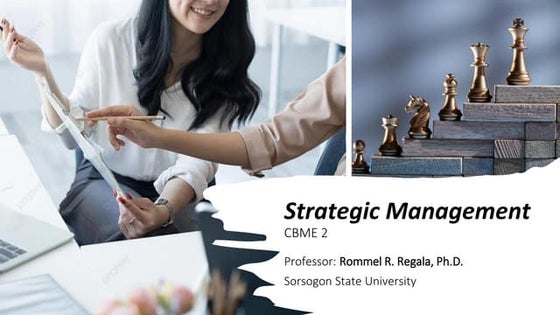



Chapter 2. Strategic Management: Corporate Governance.pdfRommel Regala
?
This course provides students with a comprehensive understanding of strategic management principles, frameworks, and applications in business. It explores strategic planning, environmental analysis, corporate governance, business ethics, and sustainability. The course integrates Sustainable Development Goals (SDGs) to enhance global and ethical perspectives in decision-making.How to Configure Proforma Invoice in Odoo 18 Sales



How to Configure Proforma Invoice in Odoo 18 SalesCeline George
?
In this slide, we°Øll discuss on how to configure proforma invoice in Odoo 18 Sales module. A proforma invoice is a preliminary invoice that serves as a commercial document issued by a seller to a buyer.RRB ALP CBT 2 RAC Question Paper MCQ (Railway Assistant Loco Pilot)



RRB ALP CBT 2 RAC Question Paper MCQ (Railway Assistant Loco Pilot)SONU HEETSON
?
RRB ALP CBT 2 RAC Question Paper MCQ PDF Free Download. Railway Assistant Loco Pilot Mechanic Refrigeration and Air Conditioning Important Questions.Odoo 18 Accounting Access Rights - Odoo 18 ∫›∫›fl£s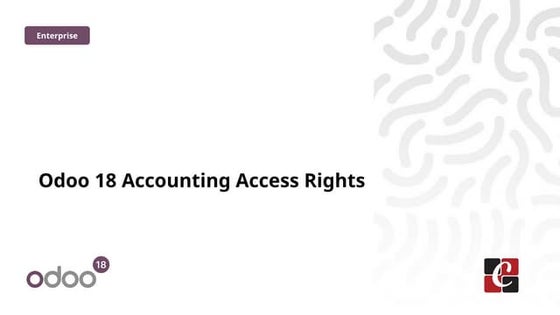



Odoo 18 Accounting Access Rights - Odoo 18 ∫›∫›fl£sCeline George
?
In this slide, we°Øll discuss on accounting access rights in odoo 18. To ensure data security and maintain confidentiality, Odoo provides a robust access rights system that allows administrators to control who can access and modify accounting data. How to Configure Recurring Revenue in Odoo 17 CRM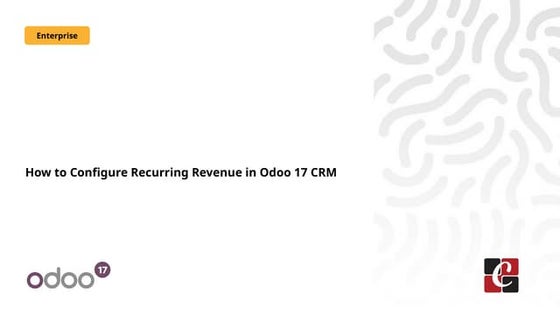



How to Configure Recurring Revenue in Odoo 17 CRMCeline George
?
This slide will represent how to configure Recurring revenue. Recurring revenue are the income generated at a particular interval. Typically, the interval can be monthly, yearly, or we can customize the intervals for a product or service based on its subscription or contract. Meeting the needs of modern students?, Selina McCoy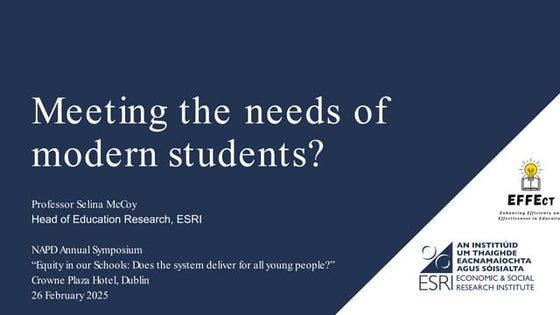



Meeting the needs of modern students?, Selina McCoyEconomic and Social Research Institute
?
NAPD Annual Symposium
°∞Equity in our Schools: Does the system deliver for all young people?°±Blind spots in AI and Formulation Science, IFPAC 2025.pdf



Blind spots in AI and Formulation Science, IFPAC 2025.pdfAjaz Hussain
?
The intersection of AI and pharmaceutical formulation science highlights significant blind spots°™systemic gaps in pharmaceutical development, regulatory oversight, quality assurance, and the ethical use of AI°™that could jeopardize patient safety and undermine public trust. To move forward effectively, we must address these normalized blind spots, which may arise from outdated assumptions, errors, gaps in previous knowledge, and biases in language or regulatory inertia. This is essential to ensure that AI and formulation science are developed as tools for patient-centered and ethical healthcare.Oral exam Kenneth Bech - What is the meaning of strategic fit?



Oral exam Kenneth Bech - What is the meaning of strategic fit?MIPLM
?
Presentation of the CEIPI DU IPBA oral exam of Kenneth Bech - What is the meaning of strategic fit? One Click RFQ Cancellation in Odoo 18 - Odoo ∫›∫›fl£s



One Click RFQ Cancellation in Odoo 18 - Odoo ∫›∫›fl£sCeline George
?
In this slide, we°Øll discuss the one click RFQ Cancellation in odoo 18. One-Click RFQ Cancellation in Odoo 18 is a feature that allows users to quickly and easily cancel Request for Quotations (RFQs) with a single click.Unit 1 Computer Hardware for Educational Computing.pptx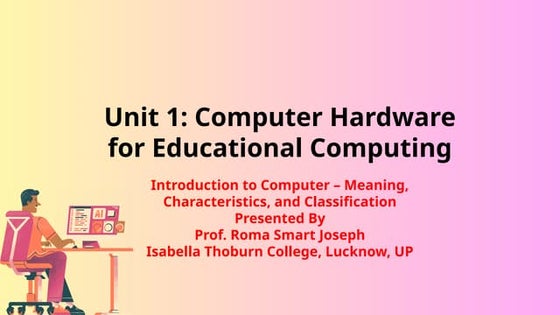



Unit 1 Computer Hardware for Educational Computing.pptxRomaSmart1
?
Computers have revolutionized various sectors, including education, by enhancing learning experiences and making information more accessible. This presentation, "Computer Hardware for Educational Computing," introduces the fundamental aspects of computers, including their definition, characteristics, classification, and significance in the educational domain. Understanding these concepts helps educators and students leverage technology for more effective learning.Azure Administrator Interview Questions By ScholarHat



Azure Administrator Interview Questions By ScholarHatScholarhat
?
Azure Administrator Interview Questions By ScholarHatHow to create security group category in Odoo 17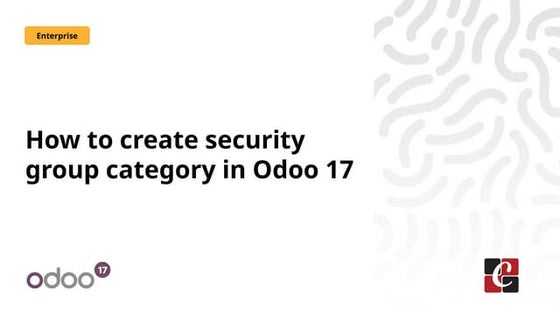



How to create security group category in Odoo 17Celine George
?
This slide will represent the creation of security group category in odoo 17. Security groups are essential for managing user access and permissions across different modules. Creating a security group category helps to organize related user groups and streamline permission settings within a specific module or functionality.AI and Academic Writing, Short Term Course in Academic Writing and Publicatio...



AI and Academic Writing, Short Term Course in Academic Writing and Publicatio...Prof. (Dr.) Vinod Kumar Kanvaria
?
AI and Academic Writing, Short Term Course in Academic Writing and Publication, UGC-MMTTC, MANUU, 25/02/2025, Prof. (Dr.) Vinod Kumar Kanvaria, University of Delhi, vinodpr111@gmail.comInventory Reporting in Odoo 17 - Odoo 17 Inventory App



Inventory Reporting in Odoo 17 - Odoo 17 Inventory AppCeline George
?
This slide will helps us to efficiently create detailed reports of different records defined in its modules, both analytical and quantitative, with Odoo 17 ERP.NUTRITIONAL ASSESSMENT AND EDUCATION - 5TH SEM.pdf



NUTRITIONAL ASSESSMENT AND EDUCATION - 5TH SEM.pdfDolisha Warbi
?
NUTRITIONAL ASSESSMENT AND EDUCATION, Introduction, definition, types - macronutrient and micronutrient, food pyramid, meal planning, nutritional assessment of individual, family and community by using appropriate method, nutrition education, nutritional rehabilitation, nutritional deficiency disorder, law/policies regarding nutrition in India, food hygiene, food fortification, food handling and storage, food preservation, food preparation, food purchase, food consumption, food borne diseases, food poisoningEffective Product Variant Management in Odoo 18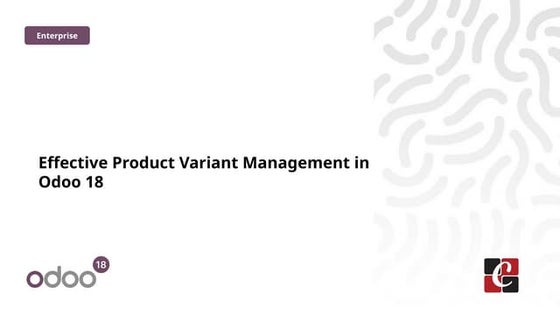



Effective Product Variant Management in Odoo 18Celine George
?
In this slide we°Øll discuss on the effective product variant management in Odoo 18. Odoo concentrates on managing product variations and offers a distinct area for doing so. Product variants provide unique characteristics like size and color to single products, which can be managed at the product template level for all attributes and variants or at the variant level for individual variants.AI and Academic Writing, Short Term Course in Academic Writing and Publicatio...



AI and Academic Writing, Short Term Course in Academic Writing and Publicatio...Prof. (Dr.) Vinod Kumar Kanvaria
?
Kanohi ki te kanohi
- 1. Kanohi ki te Kanohi- Raising awareness and knowledge that contribute to success for Maori in the education sector.
- 2. Why did we use a hui approach?To give credibility to the process of hui as a vehicle for non- threatening discussion and familiarise others with the process.To use a cultural context to enable whanau to feel acknowledged.Using a culturally responsive context also empowers educators to reflect and review their own approaches for engaging whanau.
- 3. PurposeOur target audience was local schools who are part of our South Taranaki cluster.A specific focus was to enable a diverse group of people to meet and discuss issues for Maori in the education sector:Principals and teachersWhanauStudents
- 4. FOCUS?This hui had a specific focus?To enable a diverse group of people to discuss issues for Maori in the education sector.?Principals and TeachersWhanauStudents??To present the Ministry of Education document KaHikitia??To begin the process of reflection and review of what is happening currently in °Æmy school°Ø using the Measurable Gains Framework 3.2??Presenters: Ngahina Transom Nicola Chase(Currently working with the Te Kauhua MOE Project phase 3)TiriBailey-Knowell RTM Kaareen Hotereni RTM Wiki RTM???
- 5. He aha temeanui o teao?He tangata, he tangata, he tangata.The °∞mahitahi°± groups combined school representatives to focus on aspects pertinent to the success for their children. It enabled a collective voice to be heard.
- 6. Tamariki were involved in games initially to enable them to develop a sense of working together. They were then placed in groups and a senior student given the role of group leader. All students were encouraged to have a say about what was important to them at their school and their collective voice was presented to all hui participants. It was empowering for the junior students to be mixed with senior students and for school groups to be mixed.
- 7. The power of korero from parents and students enabled us to hear the evidence of the effect education had on them. It was not about blame ®C it was what was done!
- 9. Whakahau, whakamana, whakahihiAs an NZEI initiative it reminds us of our responsibility towards raising achievement of our tamariki and celebrating our successes of doing so.Encourage, be proud and celebrate!
- 11. Thanks to the contributing schools, their students°Ø voice, their parents and staff, and the contribution of all who have enabled us to reflect, review, challenge and make changes ®C to do what we should be doing and have a responsibility to do!
Editor's Notes
- #2: TePumaomao workshop with Takawai and Christine Murphy ®C precursor of this Hui.As a result of a school review around curriculum delivery and discussion with parents, staff were aware of the need to upskill in their knowledge of Te reo and tikanga Maori. It has been quite a journey over the last 3 years. With the knowledge that our children move on to Intermediate and with some funds from the RTLB we organised a hui for other schools in our cluster, with the focus on Treaty of Waitangi. Kanohikitekanohi was the next stage.
- #3: Past experience of Ramanui discussions had acknowledged that a culturally responsive context was important. Initially we had decided on a 2 day hui held at a local marae however this was not widely supported by our cluster. We decided on a local venue, one day, however we would follow protocols so that our whanau would feel non threatened.
- #5: The use of our local Resource Teachers: Maori was invaluable. It also enabled them to meet with other Principals who may not have been aware of their availability to give assistance.
- #6: Being able to group people according to their role, ie parent, teacher, student and from a variety of schools allowed for robust discussion without fear of saying things °∞out of line°±. Notes were collated without reference to particular schools, persons.
- #7: Student voice is an excellent way to gauge the general feeling about an area. Tuakana-teina in evidence.
- #8: This was very empowering. People spoke from the heart. There was no blame attached ®C it was just °∞how it was°±. But there was a strong message for us.
- #10: This is about US! We need to take ownership, stop blaming
- #11: Student voice is our best indicator of what we are doing and its effect!!!!! These tamariki were empowered to speak up and tell us what is important to them and how what we do affects them and their perception of who and what they are. It was very humbling for many of us.





